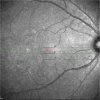Retinal Thickening and Photoreceptor Loss in HIV Eyes without Retinitis
- PMID: 26244973
- PMCID: PMC4526563
- DOI: 10.1371/journal.pone.0132996
Retinal Thickening and Photoreceptor Loss in HIV Eyes without Retinitis
Abstract
Purpose: To determine the presence of structural changes in HIV retinae (i.e., photoreceptor density and retinal thickness in the macula) compared with age-matched HIV-negative controls.
Methods: Cohort of patients with known HIV under CART (combination Antiretroviral Therapy) treatment were examined with a flood-illuminated retinal AO camera to assess the cone photoreceptor mosaic and spectral-domain optical coherence tomography (SD-OCT) to assess retinal layers and retinal thickness.
Results: Twenty-four eyes of 12 patients (n = 6 HIV-positive and 6 HIV-negative) were imaged with the adaptive optics camera. In each of the regions of interest studied (nasal, temporal, superior, inferior), the HIV group had significantly less mean cone photoreceptor density compared with age-matched controls (difference range, 4,308-6,872 cones/mm2). A different subset of forty eyes of 20 patients (n = 10 HIV-positive and 10 HIV-negative) was included in the retinal thickness measurements and retinal layer segmentation with the SD-OCT. We observed significant thickening in HIV positive eyes in the total retinal thickness at the foveal center, and in each of the three horizontal B-scans (through the macular center, superior, and inferior to the fovea). We also noted that the inner retina (combined thickness from ILM through RNFL to GCL layer) was also significantly thickened in all the different locations scanned compared with HIV-negative controls.
Conclusion: Our present study shows that the cone photoreceptor density is significantly reduced in HIV retinae compared with age-matched controls. HIV retinae also have increased macular retinal thickness that may be caused by inner retinal edema secondary to retinovascular disease in HIV. The interaction of photoreceptors with the aging RPE, as well as possible low-grade ocular inflammation causing diffuse inner retinal edema, may be the key to the progressive vision changes in HIV-positive patients without overt retinitis.
Conflict of interest statement
Figures




References
-
- Mueller AJ, Plummer DJ, Dua R, Taskintuna I, Sample PA, Grant I, et al. (1997) Analysis of visual dysfunctions in HIV-positive patients without retinitis. Am J Ophthalmol 124: 158–167. - PubMed
-
- Mutlukan E, Dhillon B, Aspinall P, Cullen JF (1992) Low contrast visual acuity changes in human immuno-deficiency virus (HIV) infection. Eye (Lond) 6 (Pt 1): 39–42. - PubMed
-
- Quiceno JI, Capparelli E, Sadun AA, Munguia D, Grant I, Listhaus A, et al. (1992) Visual dysfunction without retinitis in patients with acquired immunodeficiency syndrome. Am J Ophthalmol 113: 8–13. - PubMed
Publication types
MeSH terms
Grants and funding
LinkOut - more resources
Full Text Sources
Other Literature Sources
Medical

